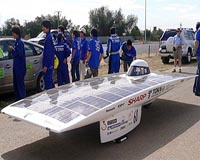 |
Wilmington DE (SPX) Oct 29, 2009 Silicon Energy, LLC and DuPont Photovoltaic Solutions announce the world's first glass-glass polycrystalline silicon (cSi) photovoltaic (PV) power-generating modules made with advanced DuPont PV5300 series ionomer-based encapsulant for added module strength and durability. "By combining the high efficiency of crystalline silicon with the new, stronger encapsulant from DuPont, our module offers a new level of physical strength, durability and improvements in design," said Gary Shaver, director of sales for Silicon Energy. High-efficiency crystalline silicon wafer technology is well-established in PV modules, but the fragile semiconductive wafer material requires protection against impact, flexing and moisture. Traditionally, this protection has been provided by surrounding the silicon wafers in a polymer called EVA, supplied in a sheet form. "Compared with EVA and other available encapsulants, the new DuPont PV5300 sheet is based on ionomer, which is up to 100 times stiffer, 5 times stronger and much more resistant to moisture intrusion," explained Steve Cluff, global encapsulants business director for DuPont Photovoltaic Solutions. "DuPont's ionomer sheet technology comes from our advanced interlayer business for safety glass, where the original challenge was to find a clear material that could help laminated glass meet hurricane codes." DuPont PV5300 Series encapsulant sheets deliver glass-like clarity plus impact resistance, high strength and proven adhesion to glass, allowing Silicon Energy to build modules suited to not only high wind loads, but also heavy snows typical during the winter season. To manufacture its module, Silicon Energy uses two 60-mil layers of the DuPont PV5300 encapsulant to surround the silicon wafers, and adds high-transmittance tempered glass to complete the structure. The resulting combination of glass and ionomer sheet material delivers significantly increased flexural strength over traditional modules. "Because the new DuPont encapsulant is more resistant to moisture intrusion, we're also able to innovate with an open-edged framing design," said Shaver. "This allows snow, water and dirt to just slide right off, which increases module performance." The new, high-strength Silicon Energy modules are designed with frames and wiring channels along the sides, making installations simple and elegant. The company's "Cascade" design not only improves visual aesthetics, it also lets more air to circulate beneath the modules, which improves module performance. DuPont announced commercial availability of its new PV5300 Series encapsulants in May 2009. Silicon Energy began testing the material about two years ago, and is the first manufacturer in the United States to complete a new module design with the material. The modules are fully certified and now being shipped commercially. Share This Article With Planet Earth
Related Links DuPont PV Series All About Solar Energy at SolarDaily.com
 Japanese car wins World Solar Challenge in Australia
Japanese car wins World Solar Challenge in AustraliaSydney (AFP) Oct 28, 2009 A Japanese sun-powered car won the World Solar Challenge on Wednesday after averaging speeds of more than 100 kilometres (62 miles) per hour in a four-day race through Australia's desert Outback. Organisers said the Tokai Challenger crossed the finish line in Adelaide, South Australia, at 3:39 pm local time, after 29 hours and 49 minutes' racing following Sunday's departure from the northern ... read more |
|
| The content herein, unless otherwise known to be public domain, are Copyright 1995-2009 - SpaceDaily. AFP and UPI Wire Stories are copyright Agence France-Presse and United Press International. ESA Portal Reports are copyright European Space Agency. All NASA sourced material is public domain. Additional copyrights may apply in whole or part to other bona fide parties. Advertising does not imply endorsement,agreement or approval of any opinions, statements or information provided by SpaceDaily on any Web page published or hosted by SpaceDaily. Privacy Statement |